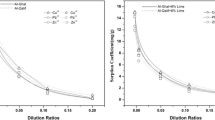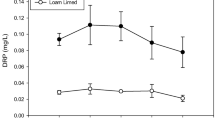Abstract
Reduction in the dissolved phosphorus (P) desorption from agricultural soils could be an effective measure to prevent eutrophication. Lime is a high calcium–containing mineral that can have promising but varying responses on P desorption depending on soil type. The main objective of this research was to evaluate and compare the potential of hydrated lime and lime kiln dust, its cheaper alternative, as soil amendments to increase soil P adsorption capacity and to reduce dissolved P desorption from four soil types (sandy, sandy loam, loam, and clay loam). A batch adsorption study with varying P concentrations of 0, 0.2, 0.4, 0.6. 0.8, and 1.0 mM P and an adsorbent dose of 1% lime by air-dried soil mass at a fixed pH of 6.5 was carried out. The adsorption data fit best the Freundlich adsorption isotherm model. Both hydrated lime and lime kiln dust significantly increased the Freundlich adsorption coefficient by 3.2, 2.4, 2.0, and 1.6 times in loam, sandy, sandy loam, and clay loam soils, respectively. Although the hydrated lime showed a higher potential to increase the Langmuir maximum adsorption capacity in comparison to lime kiln dust, they both exhibited similar performance at lower P concentration ranges that are representative of the soil solution. The cumulative phosphorus desorption in the ten consecutive days agreed with the adsorption results. Therefore, lime kiln dust as a by-product could be a promising soil amendment to increase soil phosphorus adsorption capacity leading to less phosphorus desorption to water bodies. Further studies on its interaction with crop growth at field scale are required.




Similar content being viewed by others
References
AAFC (Agriculture and Agri-Food Canada). (1948). Soil survey reports for Quebec: soil survey of Shefford, Brome and Missisquoi Counties. Report No. pq11.
AAFC (Agriculture and Agri-Food Canada). (1956). Soil survey reports for Quebec: soil survey of Montreal, Jesus and Bizard Islands. Report No. pq41.
Alizadeh, A., Prasher, S. O., ElSayed, E., Qi, Z., & Patel, R. M. (2016). Effect of biochar on fate and transport of manure-borne estrogens in sandy soil. Ecological Engineering., 97, 231–224.
Anderson, D. L., Tuovinen, O. H., Faber, A., & Ostrokowski, I. (1995). Use of soil amendments to reduce soluble phosphorus in dairy soils. Ecological Engineering., 5, 229–246.
Andersson, H., Bergstrom, L., Djodjic, F., Ulén, B., & Kirchmann, H. (2016). Lime placement on subsoil as a strategy to reduce phosphorus leaching from agricultural soils. Soil Use Management, 32, 381–389.
Anjos, J. T., & Rowell, D. L. (1987). The effect of lime on phosphorus adsorption and barley growth in three acid soils. Plant and Soil., 103, 75–82.
Beauchemin, S., & Simard, R. R. (1999). Soil phosphorus saturation degree: review of some indices and their suitability for P management in Québec, Canada. Canadian Journal of Soil Science, 79, 615–625.
Beck, R. E., & Schultz, J. S. (1972). Hindrance of solute diffusion within membranes as measured with micro porous membranes of known pore geometry. Biochimica et Biophysica Acta (BBA) – Biomembranes, 225(1), 273–303. https://doi.org/10.1016/0005-2736(72)90028-4.
Berg, U., Neumann, T., Donnert, D., Nuesch, R., & Stuben, D. (2004). Sediment capping in eutrophic lakes – efficiency of undisturbed calcite barriers to immobilize phosphorus. Applied Geochemistry, 19, 1759–1771.
Blomquist, J., Simonsson, M., Etana, A., & Berglund, K. (2017). Structure liming enhances aggregate stability and gives varying responses in clayey soils. Acta Agric Scand Sect B Soil Plant Sci, 68(4), 311–322.
Chung, H. K., Kim, W. H., Park, J., Cho, J., Jeong, T. Y., & Park, P. K. (2015). Application of Langmuir and Freundlich isotherms to predict adsorbate removal efficiency or required amount of adsorbent. Journal of Industrial and Engineering Chemistry, 28, 241–246.
Curtin, D., & Syers, J. K. (2001). Lime-induced changes in indices of soil phosphate availability. Soil Science Society of America Journal, 65, 147–152.
Dari, B., Nair, V. D., & Harris, W. G. (2017). Approaches for evaluating subsurface phosphorus loss potential from soil profiles. Agriculture, Ecosystems & Environment., 245, 92–99.
ElSayed, E., & Prasher, S. O. (2014). Sorption/desorption behavior ofoxytetracycline and sulfachloropyridazine in the soil water surfactant system. Environ. Sci. Pollut. Res, 21, 3339–3350.
Environment Canada. (2016). Nutrients in the St. Lawrence River. Retrieved on September 29, 2016 from https://www.canada.ca/en/environment-climate-change/services/environmental-indicators/nutrients-st-lawrence-river.html.
Eslamian, F., Qi, Z., Tate, M., Zhang, T., & Prasher, S. O. (2018). Phosphorus loss mitigation in leachate and surface runoff from clay loam soil using four lime-based materials. Water Air Soil Pollution., 229, 97. https://doi.org/10.1007/s11270-018-3750-0.
Eslamian, F., Qi, Z., Tate, M., & Romaniuk, N. (2020). Lime application to reduce phosphorus release in different textured intact and small repacked columns. Journal of soil and sediments, 20, 2053–2066. https://doi.org/10.1007/s11368-020-02564-9.
Freundlich, H. (1926). Colloid and Capillary Chemistry (pp. 114–122). London: Methuen.
Glaesner, N., Kjaergaard, C., Rubaek, G. H., & Magid, J. (2011). Interactions between soil texture and placement of dairy slurry application: I. Flow characteristics and leaching of nonreative components. Journal of Environmental Quality (special submissions)., 40, 331–343.
Goldberg, S., & Sposito, G. (1984). A chemical model of phosphate adsorption by soils: I. Reference oxide minerals. Soil Sci. Soc. Am. J., 48, 772–778.
Griffin, G. F. (1971). Effect of liming on soil test level of phosphorus as determined by three methods. Soil Sci. Soc. Am. Proc., 35, 540–542.
Haynes, R. J. (1982). Effects of liming on phosphate availability in acid soils. Plant and Soil., 68, 289–308.
Holford, I. C. R. (1982). Effects of phosphate sorptivity on long-term plant recovery and effectiveness of fertilizer phosphate in soils. Plant and Soil., 64, 225–236.
Holford, I. C. R., Wedderburn, R. W. M., & Mattingly, G. E. G. (1974). A Langmuir two-surface equation as a model for phosphate adsorption by soils. J. Soil Sci., 25, 242–255.
Jarvie, H. P., Sharpley, A. N., Withers, P. J. A., Scott, J. T., Haggard, B. E., & Neal, C. (2013). Phosphorus mitigation to control river eutrophication: murky waters, inconvenient truths, and “postnormal” science. Journal of Environmental Quality, 42, 295–304.
Jarvie, H. P., Johnson, L. T., Sharpley, A. N., Smith, D. R., Baker, D. B., Bruulsema, T. W., & Confesor, R. (2017). Increased soluble phosphorus loads to Lake Erie: unintended consequences of conservation practices? Journal of Environmental Quality, 46, 123–132.
Jiao, Y., Whalen, J. K., & Hendershot, W. H. (2007). Phosphate sorption and release in a sandy-loam soil as influenced by fertilizer sources. Soil Science Society of America Journal, 71, 118–124.
Kavak, A., & Baykal, G. (2012). Long-term behavior of lime-stabilized kaolinite clay. Environ Earth Sci, 66, 1943–1955.
Kelly Vargas, K. G., & Qi, Z. (2019). Phosphorus immobilizing materials for lake internal loading control: a review towards future developments. Critical Reviews in Environmental Science and Technology. https://doi.org/10.1080/10643389.2018.1551300.
King, K. W., Williams, M. R., Macrae, M. L., Fausey, N. R., Frankenberger, J., Smith, D. R., Kleinman, P. J. A., & Brown, L. C. (2015). Phosphorus transport in agricultural subsurface drainage: a review. Journal of Environmental Quality, 44, 467–485.
Kleinman, P. J. A., Sharpley, A. N., Withers, P. J. A., Bergström, L., Johnson, L. T., & Doody, D. G. (2015). Implementing agricultural phosphorus science and management to combat eutrophication. AMBIO, 44, 297–310.
Langmuir, I. (1918). The adsorption of gases on plane surfaces of glass, mica and platinum. Journal of American Chemical Society, 40, 1361–1402.
Lauchli, A. & Grattan, S. (2012). Soil pH Extremes. In Book: Plant Stress Physiology. pp194–209. https://doi.org/10.1079/9781845939953.0194
Lewis, C. J. (2005). Chemical facts pertaining to environmental uses for lime. USA: Graymont Booklet.
MacDonald, J. D., Belanger, N., & Hendershot, W. H. (2004). Column leaching using dry soil to estimate solid-solution partitioning observed in zero-tension lysimeters. 1. Method development. Soil & Sediment Contamination., 13, 361–374.
Majumdar, B., Kumar, K. S., Venkatesh, M., & Patiram. (2005). Effect of liming on phosphorus adsorption and desorption behaviour of acidic alfisols and entisol of Meghalaya. Journal of the Indian Society of Soil Science., 53, 188–193.
Mao, Y., Ninh Pham, A., Xin, Y., & David Waite, T. (2012). Effects of pH, floc age and organic compounds on the removal of phosphate by pre-polymerized hydrous ferric oxides. Sep. Purification Technol., 91, 38–45.
Mehlich, A. (1984). Mehlich 3 soil test extractant: a modification of Mehlich 2 extractant. Communications in Soil Science and Plant Analysis, 15, 1409–1416.
Murphy, J., & Riley, J. P. (1962). A modified single solution method for the determination of phosphate in natural waters. Anal Chim Acta, 27, 31–36.
Nelson, D. W. & Sommers, L. E. (1996). Chapter 34. p 1001-1006. Total carbon, organic carbon, and organic matter. In: J. M. Bigham et al. (ed.) Soil Science Society of America and American Society of Agronomy. Methods of Soil Analysis. Part 3. Chemical Methods-SSSA Book Series no. 5. Madison, WI.
Olsen, S. R., & Sommers, L. E. (1982). Phosphorus, Pages 403–430 in A.L. Page, R.H. Miller, and D.R. Keeney, Eds. Methods of Soil Analysis. Part 2. 2nd ed. Agronomy No. 9. Madison, WI, USA: American Society of Agronomy.
Parkinson, J. A., & Allen, S. E. (1975). A wet oxidation procedure suitable for the determination of nitrogen and mineral nutrients in biological material. Commun. Soil Sci. Plant Anal., 6, 1–11.
Sharpley, A., Jarvie, H. P., Buda, A., May, L., Spears, B., & Kleinman, P. (2013). Phosphorus legacy: overcoming the effects of past management practices to mitigate future water quality impairment. Journal of Environmental Quality, 42, 1308–1326.
Simonsson, M., Östlund, A., Renfjäll, L., Sigtryggsson, C., Börjesson, G., & Kätterer, T. (2018). Pools and solubility of soil phosphorus as affected by liming in long-term agricultural field experiments. Geoderma., 315, 208–219.
Sposito, V. G. (1989). The chemistry of soils. Oxford University Press.
Suresh Kumar, P., Prot, T., Korving, L., Keesman, K. J., Dugulan, I., van Loosdrecht, M. C. M., & Witkamp, G.-J. (2017). Effect of pore size distribution on iron oxide coated granular activated carbons for phosphate adsorption – Importance of mesopores. Chemical Engineering Journal, 326, 231–239.
Suresh Kumar, P., Korving, L., Keesman, K. J., van Loosdrecht, M. C. M., & Witkamp, G.-J. (2019). Effect of pore size distribution and particle size of porous metal oxides on phosphate adsorption capacity and kinetics. Chemical Engineering Journal, 358, 160–169.
Tunesi, S., Poggi, V., & Gessa, C. (1999). Phosphate adsorption and precipitation in calcareous soils: the role of calcium ions in solution and carbonate minerals. Nutrient Cycling in Agroecosystems, 53, 219–227.
Ulén, B., & Etana, A. (2014). Phosphorus leaching from clay soils can be counteracted by structure liming. Acta Agric Scand Sect B Soil Plant Sci, 64(5), 425–433.
Wang, C., & Jiang, H. (2016). Chemicals used for in-situ immobilization to reduce the internal phosphorus loading from lake sediments for eutrophication control. Critical Reviews in Environmental Science and Technology, 46(10), 947–997. https://doi.org/10.1080/10643389.2016.1200330.
Yang, X., Chen, X., & Yang, X. (2019). Effect of organic matter on phosphorus adsorption and desorption in a black soil from Northeast China. Soil and Tillage Research, 187, 85–91.
Zimdahl, R. L. (2015). Six chemicals that changed agriculture: chapter 3 - lime: a soil amendment. In R. L. Zimdahl (Ed.), Six Chemicals That Changed Agriculture (pp. 41–54). San Diego: Academic Press.
Acknowledgements
This research was conducted at the Macdonald Campus of McGill University in collaboration with Graymont to whom we would like to express our sincere thanks. We would also like to express our special gratitude to Ms. Hélène Lalande for her valuable help in the analysis of the samples in the Environmental Soil Laboratory, McGill University.
Funding
This research was equally funded by Graymont and NSERC (Natural Sciences and Engineering Research Council of Canada).
Availability of Data and Material
The data used in this result will be available upon request.
Code Availability
N/A
Author information
Authors and Affiliations
Corresponding author
Ethics declarations
Conflict of Interest
The authors declare no competing interests.
Additional information
Publisher’s Note
Springer Nature remains neutral with regard to jurisdictional claims in published maps and institutional affiliations.
Rights and permissions
About this article
Cite this article
Eslamian, F., Qi, Z. & Qian, C. Lime Amendments to Enhance Soil Phosphorus Adsorption Capacity and to Reduce Phosphate Desorption. Water Air Soil Pollut 232, 66 (2021). https://doi.org/10.1007/s11270-021-05024-3
Received:
Accepted:
Published:
DOI: https://doi.org/10.1007/s11270-021-05024-3




